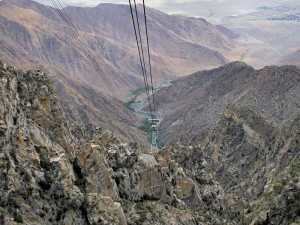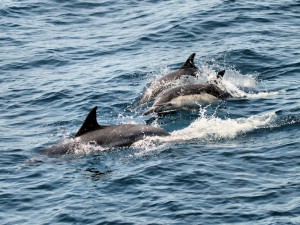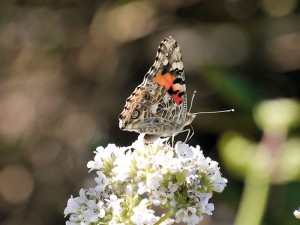During a recent visit from family, we took the famous Palm Springs Aerial Tram up to Mountain Station (see photo of Mountain Station here), the entrance to Mt. San Jacinto State Park. The ride is quite dramatic. It rises 6000 feet from a dry desert bottom to 8516 feet at Mountain Station, in under 15 minutes. The Swiss-made aerial tram cars have a rotating floor so that passengers get the full panorama during their climb without jostling for position. Once you arrive at Mountain Station, you have a choice of activities. You can visit the gift shop, catch a snack or a meal at the Peaks Restaurant. Alternatively, exit into Long Valley and take some of the hiking trails in the state park. We ended up doing all three of those. Continue reading
Monthly Archives: July 2014
Summer Pelagic Trip from Dana Point
The Summer Pelagic trip out of Dana Point sponsored by Sea & Sage Audubon was last Saturday, 12-JUL-14. On Saturday, a light wind raised a bit of chop that made it unpleasant for some trip participants, even on the 70-foot R/V Sea Explorer, and it certainly made photography a bit more challenging! Getting a good, steady view of these birds can be difficult at the best of times, and an additional source of motion doesn’t help.
Conditions in the Santa Barbara Channel seldom get anywhere near as rough as those out in the open ocean. In fact, our relatively calm waters are part of what makes these quarterly Sea & Sage Pelagic trips with the boat from the Dana Point Ocean Institute so appealing. Another advantage to these trips is the vast experience of the Ocean Institute personnel, particularly Captain Mike Bursk, whose vast knowledge of all the ocean wildlife adds greatly to the experience. Continue reading
Jamaican Owl
We made a recent excursion to Jamaica in search of the endemic Jamaican Owl. We focused our efforts on the eastern side of the island since our time was so brief. Having read that the Hotel Mockingbird on the north-east side of the island had resident Jamaican Owls made this our first destination. The hotel is a wonderful place to stay. We did hear the Jamaican Owl although never actually saw any while we were there. Adjacent to the hotel are big trees. There may indeed be Jamaican Owls roosting in them. These “wise old owls” are certainly becoming aware of the folks who come to see them. They were unfortunately not out on open branches showing off to the tourists.
Continue reading
Getting Close to Bugs
The old saying goes “Close only counts in horseshoes and hand grenades.” But we who study butterflies, dragonflies, or other small creatures, know that many other things need proximity. Getting close looks at and/or photographing them requires optics that let you see these beauties in enough detail. That means being able to focus at very short distances. On the Optics4Birding website, a binocular’s close focus distance must be less than 8 feet to be considered close-focusing. I photographed these butterflies with a lens that allows close focus as well. All these images are full frame. I have not cropped the photos, only resized them to fit our page format. The Painted Lady (above) was feeding on nectar from these flowers. Continue reading
Fireworks in Laguna Niguel Regional Park
Happy 4th of July 2014 fireworks
We went to see the fireworks near Laguna Niguel Regional Park for 4th of July. Optics4Birding is located in southern California in the city of Irvine. I live about 15 minutes from work and near the Laguna Niguel Regional Park. The hills surrounding this area open the possibility for seeing many of the firework displays in South Orange County.
From where we were we could see four different shows at once. It was really impressive. I have never tried to take photos of fireworks before so it also became a learning lesson. A little reading on the internet gave me instructions for doing this. Shortly before dark we hiked up a dirt road in the hills next to our local high school and setup my camera on a tripod. Next year’s photos promise to be much better now that I have a bit of experience with this.
Since I do quite a bit of photography at night for our owling.com web site, I hoped that this would not be too difficult. Still this is a very different type of photography. Photographing the owls at night is done at closer range using a flash. Photographing the fireworks require extended shutter times with a camera on a tripod. All considered, this is just one more method of taking photographs.
I tried several different settings to do this. The best results came from setting my ISO between 100-400 and taking a timed photo of 5 to 8 seconds. I used my 100-400mm Canon lens so I could shoot some of the distant fireworks too. The shots were taken with the aperture set at 5.6. For a first try at this, the photos were just fine and I was happy.
Happy 4th of July to all from Optics4Birding. We hope to see many of you out looking at nature this upcoming year. Enjoy the photos and try to get outdoors as much as you can. We believe at Optics4Birding that if we all enjoy the outdoors, we will protect it and its precious life.
Strange Things Revisited
We took a drive to Santa Paula in Ventura County to see this female Scissor-tailed Flycatcher (Tyrannus forticatus). It had taken up residence in a park in the center of town. I digiscoped her through a Kowa TSN-884 spotting scope with a TE-11WZ eyepiece using a Panasonic G6 camera.
Scissor-tailed Flycatcher Range
Scissor-tailed Flycatchers’ normal range is in the south central U.S. They are common in Texas, Oklahoma, Kansas, and the western portions of Missouri, Arkansas, and Louisiana. In Southern California, Scissor-tailed Flycatchers usually show up in winter and leave in spring. Having one in summer is quite rare.
Strange Occurrence
The reason this female is still around is quite obvious: she is tending a nest. What’s even more interesting is there is not a male Scissor-tailed Flycatcher around and a male Western Kingbird seems to be watching over the nest when mom is out feeding herself. It will be interesting to see whether she fledges some interesting hybrids. Recent reports from Santa Paula question whether there are truly eggs in the nest. Some observers report seeing her “adjusting eggs”, while others say she is spending most of her time eating for herself and not tending the nest. Eggs would have hatched by now and no young have been seen.











